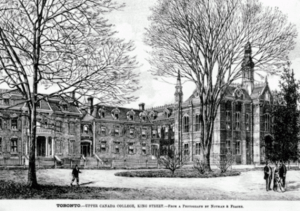Eden Smith
| Eden Smith | |
|---|---|
| Born |
1858 Birmingham, England |
| Died |
10 October 1949 Toronto, Ontario |
| Nationality | Canadian |
| Occupation | Architect |
| Buildings | Grace Church on the Hill; St. Thomas Anglican Church; Upper Canada College; Thornton Hall Private School |
Eden Smith (1858 - 10 October 1949) was born in Birmingham, England but achieved fame as a Toronto, Ontario architect belonging to the Arts and Crafts movement. He was a founding member of The Arts and Letters Club of Toronto (in 1908) and first president of the Architectural Eighteen Club (in 1900).
Toronto buildings
Smith was a prolific Toronto architect who designed a variety of buildings, although he is best remembered for his domestic architecture. He arrived in Toronto in 1888 with his wife Annie, and began Eden Smith architectural practice in 1892.
.jpg)
His early buildings include St. Simon, near Bloor St. E. and St. John the Evangelist, Portland St., otherwise known as the Garrison Church, which was demolished in November, 1963, Grace Church on the Hill and St. Thomas's Anglican Church (Toronto), where he was a parishioner. He designed the preparatory school of Upper Canada College and the Forest Hill residence of Frederick Wilhelm Kischel (later the site of Thornton Hall Private School). Smith built St. Hilda's College (1899), on the grounds of Trinity College, (now University of Trinity College) originally located in what is now Trinity Bellwoods Park; and Devonshire Place (1907) Devonshire House Residences, both on the grounds of the University of Toronto.[1]
During the First World War, he built three Carnegie libraries for the Toronto Public Library: the Wychwood branch, the High Park branch, and the Beaches branch. In 1913, he designed the Riverdale Courts, later the Bain Co-op, an early low-income housing project near Withrow Park in Riverdale. He is also credited with the Studio Building (Toronto), which was the non-profit home/studio of many of the Group of Seven (artists).
He designed many of the homes in the Wychwood Park neighbourhood and is thought to have built approximately 2,500 residences in Toronto over his career. His homes are strongly influenced by the English Arts and Crafts movement and many fall within the English Cottage style with steeply pitched roofs, tall chimneys, bands of small-paneled casement windows, and side-center internal plans.
He retired in 1925, marking the end of the Eden Smith & Son practice which he ran with the assistance of his younger son Ralph Eden Smith (1890 - 1972). He died on October 10, 1949 and is buried in Woodlawn Cemetery in Guelph, ON. His elder son Harry Smith had also been an architect and worked with his father from 1907 until World War I. EdenSmith Lane, located in Toronto's Cabbagetown neighbourhood, honours Eden Smith who had been a resident of nearby Salisbury Street. His public housing co-op project, located in Cabbagetown at Spruce and Sumach Streets, was built in 1917 and is another example of his work.
Works
 St. Simon's Anglican Church
St. Simon's Anglican Church Bain Co-op (1913)
Bain Co-op (1913)- Grace Church on the Hill (1912)
 Upper Canada College (1879)
Upper Canada College (1879)
External links
- Complete list of Toronto buildings attributed to Smith
- Biographical Dictionary of Architects in Canada 1800 - 1950
References
- ↑ http://dictionaryofarchitectsincanada.org/architects/view/1310 Eden Smith (architect)
| Wikimedia Commons has media related to Eden Smith. |